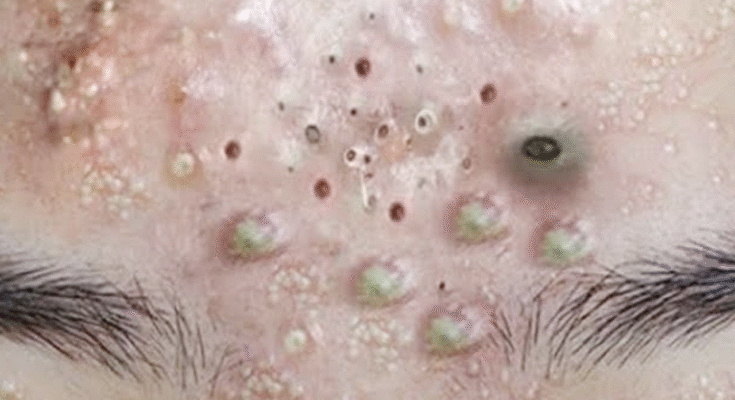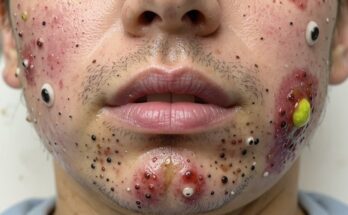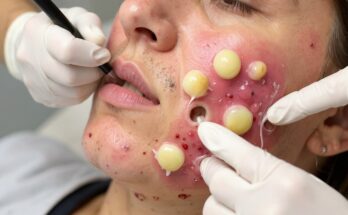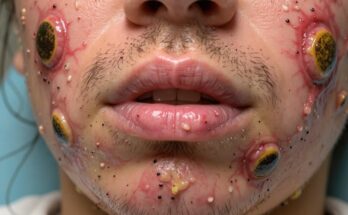Acne may fade, but the marks it leaves behind often linger — long after the blemishes have healed. For many people, acne scars and hyperpigmentation are as distressing as active breakouts themselves. They can affect confidence, make skin appear uneven, and feel impossible to treat despite countless creams and treatments.
But here’s the good news: modern dermatology offers effective, scientifically proven ways to fade acne scars and pigmentation, restore radiance, and even out your skin tone — safely and sustainably.
This guide dives deep into everything you need to know: the science behind scars, the different types, treatment options that actually work, and how to prevent future marks from forming.
1. Understanding Acne Scars and Post-Inflammatory Hyperpigmentation (PIH)
Before you can treat acne marks effectively, it’s essential to understand what type of marks you’re dealing with — because not all are the same.
1.1 Acne Scars vs. Hyperpigmentation: What’s the Difference?
Many people use “acne scars” to describe all post-acne marks, but medically speaking, that’s not entirely accurate.
| Type | Cause | Appearance | Treatment Focus |
|---|---|---|---|
| True Acne Scars | Structural damage to the skin from inflammation | Depressions or raised areas on the skin | Collagen remodeling (microneedling, laser, peels) |
| Post-Inflammatory Hyperpigmentation (PIH) | Overproduction of melanin after acne heals | Flat dark spots (brown, red, or purple) | Pigment reduction (topicals, exfoliation, brightening agents) |
In short:
-
Scars = texture issue
-
Hyperpigmentation = color issue
They can coexist, but they’re treated differently.
2. The Science Behind Acne Scars
2.1 How Acne Scars Form
When a pimple becomes inflamed — especially cystic acne — the skin’s structure is disrupted. The immune system rushes to heal the wound by producing collagen.
However, the process isn’t always perfect:
-
Too little collagen → depressed (atrophic) scars
-
Too much collagen → raised (hypertrophic) scars
2.2 Types of Acne Scars
1. Ice Pick Scars
-
Deep, narrow, V-shaped scars.
-
Look like small puncture marks.
-
Hardest to treat — usually need advanced dermatological procedures.
2. Boxcar Scars
-
Wider, U-shaped depressions with sharp edges.
-
Often appear on the cheeks and temples.
-
Caused by loss of collagen and fat under the skin.
3. Rolling Scars
-
Wave-like, shallow indentations.
-
Caused by fibrous bands pulling the skin downward.
-
Respond well to microneedling or subcision.
4. Hypertrophic & Keloid Scars
-
Raised, firm, and sometimes itchy.
-
More common on the chest, shoulders, and jawline.
-
Result from excessive collagen formation during healing.
3. The Science Behind Post-Inflammatory Hyperpigmentation (PIH)
3.1 What Causes PIH?
PIH occurs when the skin produces too much melanin (pigment) after inflammation. When a pimple heals, melanocytes — pigment-producing cells — go into overdrive, leaving behind dark spots.
3.2 PIH vs. PIE (Post-Inflammatory Erythema)
| Condition | Color | Cause | Treatment |
|---|---|---|---|
| PIH | Brown or black | Melanin overproduction | Brightening ingredients (vitamin C, niacinamide, hydroquinone) |
| PIE | Pink or red | Damaged blood vessels | Laser therapy, niacinamide, azelaic acid |
4. Step-by-Step Strategy to Fade Acne Scars & Hyperpigmentation
There’s no one-size-fits-all cure — the key is combining patience, consistent skincare, and targeted treatments. Here’s how to build an evidence-based plan.
Step 1: Stop New Breakouts First
You can’t fade marks if new acne keeps forming. Ongoing inflammation resets the healing process.
Tips:
-
Use salicylic acid (BHA) or benzoyl peroxide to control breakouts.
-
Incorporate a topical retinoid (adapalene, tretinoin).
-
Keep your skincare non-comedogenic (won’t clog pores).
-
Avoid picking or squeezing pimples — it causes deeper scarring.
Step 2: Exfoliate Strategically
Exfoliation removes dead cells, speeds up cell turnover, and fades surface discoloration. But balance is key — overdoing it can worsen irritation.
Types of Exfoliants:
-
Chemical exfoliants (AHAs & BHAs) – dissolve bonds between dead cells.
-
Enzyme exfoliants – gentler, from fruit extracts.
-
Physical scrubs – use sparingly (risk of microtears).
Best exfoliating ingredients:
-
Glycolic acid (AHA) – brightens, smooths texture.
-
Lactic acid – mild, hydrates while exfoliating.
-
Salicylic acid (BHA) – penetrates pores, treats acne and discoloration.
Routine tip:
Start 2–3 times per week, then increase frequency as tolerated.
Step 3: Brighten and Fade Pigmentation
After exfoliation, add brightening ingredients to reduce melanin production and even out tone.
Top Proven Brightening Agents:
| Ingredient | Action | Notes |
|---|---|---|
| Vitamin C (L-Ascorbic Acid) | Antioxidant; inhibits melanin | Use in the morning under SPF |
| Niacinamide | Reduces melanin transfer; anti-inflammatory | Safe for sensitive skin |
| Azelaic Acid | Targets both acne & pigmentation | Great for rosacea-prone skin |
| Alpha Arbutin | Lightens discoloration by inhibiting tyrosinase | Works well in serums |
| Kojic Acid | Natural brightener from mushrooms | Use sparingly; can be irritating |
| Tranexamic Acid | Reduces UV-induced pigmentation | Often used in professional-grade serums |
| Licorice Root Extract | Calms redness and lightens dark spots | Ideal for sensitive skin types |
Pro Tip: Combine niacinamide + vitamin C or azelaic acid for synergistic effects — more even tone without irritation.
Step 4: Stimulate Collagen Regeneration
For textured or depressed scars, focus on collagen remodeling.
a. Topical Retinoids
Retinoids (like tretinoin or adapalene) are the gold standard. They:
-
Boost collagen synthesis.
-
Smooth rough texture.
-
Fade pigmentation over time.
Start slowly (2–3 nights a week) and always use sunscreen.
b. Microneedling
This minimally invasive procedure creates controlled micro-injuries, triggering new collagen production. Over 3–6 sessions, it can significantly improve rolling or boxcar scars.
c. Laser Therapy
-
Fractional CO₂ or Er:YAG lasers for deep scars.
-
Pulsed dye or IPL lasers for redness and PIE.
Lasers stimulate new collagen and resurface the skin.
d. Chemical Peels
Medium-depth peels (like TCA or Jessner’s) exfoliate and renew skin layers, fading discoloration and smoothing texture.
e. PRP (Platelet-Rich Plasma) Therapy
Using your own platelets, PRP stimulates collagen and accelerates scar healing — often paired with microneedling for enhanced results.
Step 5: Moisturize and Protect the Skin Barrier
Barrier health is often overlooked but critical for fading marks.
Damaged skin barriers cause irritation, redness, and uneven healing.
Key ingredients:
-
Ceramides: Rebuild skin’s natural barrier.
-
Hyaluronic acid: Boosts hydration, plumps skin.
-
Panthenol: Soothes and repairs.
-
Centella Asiatica (Cica): Reduces inflammation and supports recovery.
Look for lightweight, non-comedogenic moisturizers that seal in moisture after treatments.
Step 6: Never Skip Sunscreen
UV exposure darkens pigmentation and delays healing — no matter what treatments you’re using.
-
Use broad-spectrum SPF 30–50 daily.
-
Reapply every 2–3 hours if outdoors.
-
Prefer mineral sunscreens (zinc oxide, titanium dioxide) for sensitive skin.
-
If prone to pigmentation, look for SPF with iron oxides (protects from visible light too).
Without sunscreen, even the best serums and lasers won’t deliver results.
5. In-Clinic Treatments for Faster Results
Sometimes topical treatments aren’t enough, especially for deep or old scars. Dermatologists can offer advanced procedures that target the root cause more efficiently.
5.1 Microneedling with RF (Radiofrequency)
Combines collagen induction with heat energy to tighten skin and reduce atrophic scars.
5.2 Chemical Peels (Medium to Deep)
-
Glycolic or Lactic Acid Peels: Great for surface pigmentation.
-
TCA Cross: Focused spot application for ice pick scars.
-
Phenol Peels: Reserved for severe cases under medical supervision.
5.3 Laser Treatments
-
Fractional CO₂ Laser: Deep resurfacing; powerful for old scars.
-
Erbium Laser: Gentler resurfacing, faster recovery.
-
Pulsed Dye Laser: Treats redness and vascular scars.
5.4 Subcision
A minor surgical procedure to release fibrous bands under rolling scars, allowing the skin to lift naturally.
5.5 Dermal Fillers
Temporary hyaluronic acid fillers can raise depressed scars for smoother texture.
5.6 Cryotherapy (for Raised Scars)
Freezes hypertrophic tissue to flatten it over multiple sessions.
6. Natural & At-Home Remedies (Science-Based)
While clinical treatments yield faster results, consistent at-home care can make a big difference — if you use ingredients with proven efficacy.
6.1 Effective Natural Brighteners:
-
Aloe Vera: Anti-inflammatory and soothing; helps with PIH.
-
Green Tea Extract: Rich in antioxidants; reduces redness.
-
Licorice Root: Contains glabridin, which inhibits melanin.
-
Turmeric (Curcumin): Anti-inflammatory and brightening — best used in gentle formulations.
6.2 Avoid:
-
Lemon juice, baking soda, or undiluted essential oils — these can irritate and worsen pigmentation.
7. The Role of Diet, Lifestyle & Supplements
7.1 Skin-Friendly Nutrients:
-
Vitamin C & E: Antioxidants that support healing.
-
Zinc: Anti-inflammatory and immune-supporting.
-
Omega-3 Fatty Acids: Regulate oil production and inflammation.
-
Collagen Peptides: May improve elasticity over time.
7.2 Lifestyle Tips:
-
Sleep: 7–9 hours for cell repair.
-
Hydration: At least 2–3 liters of water daily.
-
Stress Management: High cortisol worsens acne and delays healing.
-
Avoid smoking: Restricts blood flow and slows repair.
8. Prevention: Stopping New Scars Before They Start
-
Treat acne early and effectively.
-
Avoid picking, squeezing, or popping pimples.
-
Maintain consistent skincare.
-
Always protect your skin from UV exposure.
-
Use retinoids to boost cell turnover and prevent future pigmentation.
9. Emotional Impact: Healing More Than the Skin
Post-acne scars and pigmentation don’t just affect your appearance — they can deeply influence confidence and self-esteem.
It’s common to feel discouraged when progress is slow, but skin healing takes time.
Remember:
-
You’re not alone — nearly 50 million people deal with acne scarring.
-
Dermatological progress is measurable within 3–6 months of consistent care.
-
Every small improvement adds up to lasting results.
Be patient and compassionate with your skin. Healing is both physical and emotional.
10. Key Takeaways
| Concern | Main Treatment Focus | Best Options |
|---|---|---|
| Post-Inflammatory Hyperpigmentation | Brightening & pigment inhibition | Vitamin C, Niacinamide, Azelaic Acid, Sunscreen |
| Atrophic Scars | Collagen stimulation | Microneedling, Retinoids, Laser, PRP |
| Hypertrophic/Keloid Scars | Flattening raised tissue | Steroid injections, Silicone gels, Cryotherapy |
| PIE (Red Marks) | Vascular reduction | Laser, Niacinamide, Azelaic Acid |
11. Long-Term Maintenance: Keeping Skin Clear and Even
-
Stick to your skincare routine — consistency beats intensity.
-
Introduce actives slowly to avoid irritation.
-
Continue using brightening ingredients even after marks fade (maintenance mode).
-
Schedule yearly dermatology check-ins for skin assessment.
12. The Bottom Line
Acne scars and hyperpigmentation don’t define your skin’s potential. With today’s dermatological knowledge, patience, and the right combination of treatments — clear, radiant, even-toned skin is absolutely achievable.
The journey to fading scars isn’t about perfection; it’s about progress. Each layer of care — from sun protection to collagen renewal — brings you one step closer to confidence and clarity.
Healing takes time, but your skin remembers everything you do to help it recover. Treat it gently, nourish it consistently, and trust the process — because beautiful skin is healthy skin.



